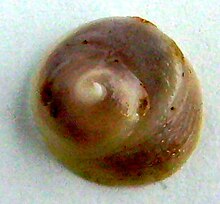Calyptraeidae
| Calyptraeidae | |
|---|---|
 | |
| A shell of Sigapatella novaezelandiae | |
Scientific classification | |
| Kingdom: | Animalia |
| Phylum: | Mollusca |
| Class: | Gastropoda |
| (unranked): | clade Caenogastropoda clade Hypsogastropoda clade Littorinimorpha |
| Superfamily: | Calyptraeoidea Lamarck, 1809 |
| Family: | Calyptraeidae Lamarck, 1809 |
| Genera | |
See text. | |
Synonyms[1] | |
| |
The Calyptraeidae, the slipper snails or slipper limpets, cup-and-saucer snails, and Chinese hat snails, are a family of small to medium-sized marine prosobranch gastropods. This family includes the slipper snails (Crepidula species), the Chinese hat snails, (Calyptraea species), and the cup-and-saucer snails (Crucibulum species) among others.
The Calyptraeidae are the only family in the superfamily Calyptraeoidea. This family has no subfamilies according to the taxonomy of the Gastropoda by Bouchet & Rocroi, 2005.
Crepidula fornicata was brought to Europe on imported American oysters in the late 19th century and is now considered a significant pest in European oyster beds.[2]
Contents
1 Description
2 Reproduction
3 Genera
4 References
5 External links
Description
Internally, the shell is distinguished by a shelf-like, cup-like, or half-cup-like structure used for muscle attachment. Some calyptraeids have shells that externally resemble those of limpets, so species in the genus Crepidula are often called slipper limpets. However, these snails are not closely related to true limpets and are more closely related to conches and cowries. The "slipper" in the name "slipper limpet" is based on the appearance of the inside of the shell, which with its half-shelf resembles a traditional western bedroom slipper.
Reproduction
Calyptraeids may form a tower of up to 25 animals, sometimes referred to as a mating chain. The bottom snail is always female. When she dies, the male above her will change from male to female, and the chain continues.[3]
Genera

Shells of Crepidula fornicata
Genera within the family Calyptraeidae include:[4][5][6]
Bicatillus Swainson, 1840
Bostrycapulus Olsson & Harbison, 1953
Calyptraea Lamarck, 1799
Crepidula Lamarck, 1799
Crepipatella Lesson, 1831
Crucibulum Schumacher, 1817
Desmaulus Rehder, 1943
Grandicrepidula McLean, 1995
Maoricrypta Finlay, 1926
Sigapatella Lesson, 1930
Siphopatella Lesson, 1831
Trochita Schumacher, 1817
- Genera brought into synonymy
Cheila Modeer, 1793: synonym of Cheilea Modeer, 1793 - this is actually in the Hipponicidae, not the Calyptraeidae.
Clypeola Gray, 1868 accepted as Sigapatella Lesson, 1831
Crypta Gray, 1847: synonym of Crepidula Lamarck, 1799
Ergea H. Adams & A. Adams, 1854: synonym of Siphopatella Lesson, 1831
Garnotia Gray, 1857: synonym of Crepidula Lamarck, 1799
Ianacus Mörch, 1852 accepted as Crepidula Lamarck, 1799
Zeacrypta Finlay, 1926 : synonym of Maoricrypta Finlay, 1926
Zegalerus Finlay, 1927 : synonym of Sigapatella Lesson, 1831
References
^ Bouchet, P.; Rocroi, J.-P. (2005). "Classification and Nomenclator of Gastropod Families". Malacologia. 47 (1–2)..mw-parser-output cite.citation{font-style:inherit}.mw-parser-output q{quotes:"""""""'""'"}.mw-parser-output code.cs1-code{color:inherit;background:inherit;border:inherit;padding:inherit}.mw-parser-output .cs1-lock-free a{background:url("//upload.wikimedia.org/wikipedia/commons/thumb/6/65/Lock-green.svg/9px-Lock-green.svg.png")no-repeat;background-position:right .1em center}.mw-parser-output .cs1-lock-limited a,.mw-parser-output .cs1-lock-registration a{background:url("//upload.wikimedia.org/wikipedia/commons/thumb/d/d6/Lock-gray-alt-2.svg/9px-Lock-gray-alt-2.svg.png")no-repeat;background-position:right .1em center}.mw-parser-output .cs1-lock-subscription a{background:url("//upload.wikimedia.org/wikipedia/commons/thumb/a/aa/Lock-red-alt-2.svg/9px-Lock-red-alt-2.svg.png")no-repeat;background-position:right .1em center}.mw-parser-output .cs1-subscription,.mw-parser-output .cs1-registration{color:#555}.mw-parser-output .cs1-subscription span,.mw-parser-output .cs1-registration span{border-bottom:1px dotted;cursor:help}.mw-parser-output .cs1-hidden-error{display:none;font-size:100%}.mw-parser-output .cs1-visible-error{font-size:100%}.mw-parser-output .cs1-subscription,.mw-parser-output .cs1-registration,.mw-parser-output .cs1-format{font-size:95%}.mw-parser-output .cs1-kern-left,.mw-parser-output .cs1-kern-wl-left{padding-left:0.2em}.mw-parser-output .cs1-kern-right,.mw-parser-output .cs1-kern-wl-right{padding-right:0.2em}
^ "Crepidula fornicata". Joint Nature Conservation Committee. 2006-04-24.
^ "In Pictures: Strange seas". BBC News. 2010-01-19.
^ "Calyptraeidae". Integrated Taxonomic Information System.
^ Powell A. W. B. (1979) New Zealand Mollusca. William Collins Publishers Ltd, Auckland, New Zealand,
ISBN 0-00-216906-1.
^ Calyptraeidae at gastropods.com Archived September 27, 2007, at the Wayback Machine.
External links
| Wikimedia Commons has media related to Calyptraeidae. |